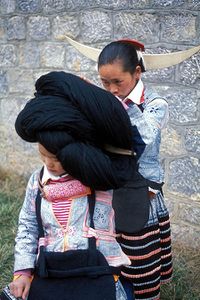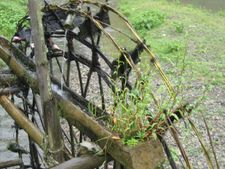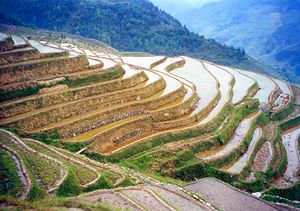مياو (شعب)
| ||||||||||||||
مياو (Chinese: 苗; pinyin: Miáo؛ إنگليزية: Miao) هي جماعة عرقية تعترف بها حكومة الصين كواحدة من 55 جماعة أقلية رسمية. مياو هو المصطلح في اللغة الصينية ولا يعكس الأسماء الذاتية للجماعات المكونة لهذا الشعب، والتي تضم (مع بعض التباين في التهجي) همونگ، هموب، شونگ (چو-شيونگ)، و آ-هماو.
الحكومة الصينية جمعت هذا الشعب مع شعوب أخرى لا علاقة لها بالمياو وعرّفتهم كجماعة واحدة، أعضاؤها ليسو بالضرورة مترابطين لغوياً أو ثقافياً، إلا أن الأغلبية هم أبناء العائلة اللغوية مياو-ياو، التي تضم الهمونگ، هموب، شونگ و آ-هماو، كما تتقاسم الأغلبية بعش التشابهات الثقافية. وللأسباب المعطاة آنفاً، فإن العديد من الشعوب المياو لا يستطيعون التواصل مع بعضهم البعض بلغاتهم الأصلية، ولكل منهم تاريخ وثقافة مختلفة عن الآخرين. وقليل من المجموعات التي تصنفها الصين كمياو لا يتفقون حتى على انتمائهم للجماعة العرقية، إلا أن معظم جماعات المياو، مثل الهمونگ والهموب، يتفقون مع التصنيف الجماعي كجاعة عرقية واحدة.
ويعيش المياو أساساً في المقاطعات الجبلية بجنوب الصين، في مقاطعات گويژو، هونان، يوننان، سيشوان، گوانگشي, هاينان، گوانگدونگ, وهوبـِيْ. بعض أعضاء الجماعات الفرعية من المياو، وعلى الأخص شعب الهمونگ، هاجروا من الصين إلى جنوب شرق آسيا (شمال ڤيتنام، لاوس، بورما (ميانمار) وتايلند). وإثر استيلاء الشيوعيين على لاوس في 1975، a large group of Hmong refugees resettled in several Western nations, mainly in the الولايات المتحدة, France, and Australia. There has been a recent tendency by Hmong Americans to group all Miao peoples together under the term Hmong because of their disdain for the Chinese term Miao. This however fails to recognize that the Hmong are only a subgroup within the broader linguistic and cultural family of Miao people and the vast majority of Miao people do not classify themselves as Hmong and have their own names for themselves.
| مياو | |||
|---|---|---|---|
| الصينية | 苗族 | ||
| |||
مصطلحات: مياو و همونگ



The term "Miao" gained official status in 1949 as a minzu (ethnic group) encompassing a group of linguistically-related ethnic minorities in Southwest China. This was part of a larger effort to identify and classify minority groups to clarify their role in the national government, including establishing autonomous administrative divisions and allocating the seats for representatives in provincial and national government.[2]
Though the Miao themselves use various self-designations, the Chinese traditionally classify them according to the most characteristic colour of the women's clothes. The list below contains some of these self-designations, the colour designations, and the main regions inhabited by the four major groups of Miao في الصين:
- Ghao Xong/Qo Xiong; Xong; Red Miao; Qo Xiong Miao: غرب هونان
- Gha Ne/Ka Nao; Hmub; Black Miao; Mhub Miao: جنوب شرق گويژو
- A-Hmao; Big Flowery Miao: west Guizhou and northeast يوننان
- Gha-Mu; Hmong, Mong; White Miao, Green/Blue Miao, Small Flowery Miao; south and east Yunnan, south Sichuan وغرب گويژو
الديمغرافيا

- Note: The Miao areas of Sichuan province became part of the newly created Chongqing Municipality in 1997.
Most Miao currently live in China. Miao population growth in China:
- 1953: 2,510,000
- 1964: 2,780,000
- 1982: 5,030,000
- 1990: 7,390,000
3,600,000 Miao, about half of the entire Chinese Miao population, were in گويژو in 1990. The Guizhou Miao and those in the following six provinces make up over 98% of all Chinese Miao:
- هونان: 1,550,000
- Yunnan: 890,000
- Sichuan: 530,000
- Guangxi: 420,000
- Hubei: 200,000
- Hainan: 50,000 (known as Miao but ethnically Yao and Li)
التاريخ

التاريخ حسب الأساطير الصينية واعتبارات أخرى
حسب الأسطورة الصينية، فإن المياو ينحدرون من قبيلة جيولي التي كان زعيمها Chiyou (بالصينية: 蚩尤 pinyin: Chīyóu) وقد انهزموا في معركة ژوولو (بالصينية: 涿鹿 pinyin: Zhuōlù ، وهي محافظة لاغية على حدود المقاطعات الحالية هبـِيْ و لياوننگ) بواسطة تحالف عسكري من هوانگ دي (بالصينية: 黃帝 pinyin: Huángdì) و يان دي، زعماء القبائل التي تصارعت على سيادة وادي النهر الأصفر.
الاكتشافات الأثرية
التوزيع
انظر أيضاً
- Chiyou
- الجماعات العرقية في التاريخ الصيني
- الأقليات العرقية في الصين
- تاريخ الصين
- همونگ (شعب)
- عادات وتقاليد الهمونگ
- Hmong–Mien languages
- لغات الصين
- List of Hmong/Miao People
- Pole worship
- Vang Pao
الهامش
للاستزادة
- Ch'ien Lung (emperor of China.) (1810). The conquest of the Miao-tse, an imperial poem ... entitled A choral song of harmony for the first part of the Spring [tr.] by S. Weston, from the Chinese. Translated by Stephen Weston. LONDON: Printed & Sold by C. & R. Baldwin, New Bridge Street, Black Friars. Retrieved 24 April 2014.
{{cite book}}: Invalid|ref=harv(help); horizontal tab character in|others=at position 14 (help)
وصلات خارجية
- Articles containing Hmong-language text
- Pages using infobox ethnic group with unsupported parameters
- Articles using infobox ethnic group with image parameters
- Articles containing Chinese-language text
- Articles containing إنگليزية-language text
- Pages using Lang-xx templates
- Articles containing صينية-language text
- Articles with unsourced statements from May 2015
- CS1 errors: invisible characters
- Ethnic groups officially recognized by China
- جماعات عرقية في لاوس
- جماعات عرقية في تايلند
- جماعات عرقية في ڤيتنام
- مياو (شعب)
- همونگ







